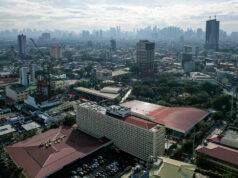ADB pares Philippine growth projection
THE ASIAN DEVELOPMENT BANK (ADB) has slashed its Philippine economic growth forecast for this year, citing impact of the four-month delay in 2019 national budget enactment and slowing export of goods and services — although the country will still be the region’s third-fastest growing economy behind Vietnam and China.
The Asian Development Outlook Supplement released on Thursday showed that the ADB’s projection for Philippine economic growth at 6.2% this year, compared to the previous forecast of 6.4% given in September 2018 that was maintained last April.
The reduced forecast matches the Philippines’ pace of economic growth last year and compares to a downgraded official 6-7% 2019 target adopted by state economic managers in March, down from 7-8% originally.
“Growth moderated in the Philippines from 6.3% year-on-year in Q4 of 2018 to 5.6% in Q1 of this year as the delayed passage of the national budget held back government spending. Public construction contracted by 8.6% while growth in government consumption eased from 12.6% year-on-year in Q4 of 2018 to 7.4% in Q1 of 2019,” the ADB said.
“Growth in exports of goods and services also slowed as a result of lackluster global trade and economic activity and the downturn in the electronics cycle. These effects were partly offset by higher household consumption and private investment,” it noted.
“As a consequence of these developments in Q1, the growth forecast is revised down to 6.2% for 2019, though maintained at 6.4% for 2020.”
President Rodrigo R. Duterte signed into law the P3.662-trillion 2019 national budget last Apr. 15 with nearly a third of the year over. Reenactment of the 2018 budget on Jan. 1 had prevented new projects from being funded until then.
Finance Secretary Carlos G. Dominguez III had said that the government will be hard-pressed to catch up with its P3.774-trillion spending program for this year, equivalent to 19.6% of gross domestic product (GDP) — of which infrastructure expenditures are programmed at P1 trillion, equivalent to 5.2% of GDP (with the national government accounting for P808.7 billion) — especially since the second semester is usually beset by heavy rains and storms that disrupt infrastructure work.
“Public investment is expected to rebound in the second half of 2019 following budget approval in April and to pick up next year as more infrastructure projects come on stream,” ADB said of the Philippines in its latest report, a prospect shared by Philippine monetary authorities, who believe that “catch-up fiscal spending is expected to buoy the growth momentum in 2019,” according to highlights of the June 20 policy review which the central bank published on Thursday.
ADB’s downgraded projection for the Philippines this year will still be the region’s third-fastest after Vietnam (6.8%) and China (6.3%), and will be faster than Southeast Asia’s 4.8% and the 5.7% penciled for “Developing Asia”, a group that consists of 45 of ADB’s 68 members (49 of which are from within Asia and the Pacific).
Inflation will be supportive of growth in the Philippines, which had seen successive multi-year-high rates culminating with a nine-year-high 6.7% in September and October. The overall price increase for goods and services has since been on a general downtrend, averaging 3.4% last semester against the central bank’s 2-4% target range for 2019 and 2018’s decade-high 5.2%.
“Slowing inflation, low unemployment, and steady remittances will continue to support household consumption,” read the report, which showed the Philippines’ inflation projection at three percent this year, down from 3.8% previously — “reflecting lower food prices” — and maintained at 3.5% in 2020 “with an expected pickup in global commodity prices.” — Reicelene Joy N. Ignacio



